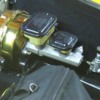quote:
Originally posted by ZR1 Pantera:
De-tuning the brakes because they lockup, is like removing power from the engine because the tires break loose under acceleration.
Yes, an adjustable proportion valve is a good idea to adjust brake balance. Once the brake system is balanced, locking up the tires is either poor driving skills or poor tires IMO...
No offense intended (I mean this sincerely...)
I don't know that I am disagreeing with you as much as I am debating this with myself.
If you have ever driven a 65 or 66 Shelby GT350, you would discover that it is absolutely impossible to lock up the brakes.
If you look at the brake rules discription for the 68 and later (into the '70s) rules for the GT cars like the Gulf (John Wyer era GT40), Lola T70, Porsche 930, the size of the brakes are limited.
You can play with rules like this as a ruling body to make cars more competitive. If you look at those cars and compare them to the Can-Am cars, there really isn't a tremendous difference.
There is a difference in safety factors though. The Can-Am cars are just plain lethal, as proven in their mortality rates, and the GT's have a better record as far as less people killed.
Now, they didn't restrict the size of the brakes to get less stopping, they did it to make the drivers less daring and drive within the car, and not outside of it's limitations.
The Can-Am cars had huge brakes, reduced weight, and huge horsepower engines, for their era. 600hp then was not obtainable by everyone. Now more than that is in street cars.
The formula didn't work. They ran off the tracks in the corners and into any obstruction they could find.
Granted these were crude days of air effect wings. They were there but compared to the computer controlled wings that change as the g loads and speeds did, like in Formula 1 now, they were pre-school, pre-science projects.
What I am saying here, is that there is a real issue with inability to put enough tire on the car, a real ability to put a lot of power into the car.
I'm not sure that I am capable of balancing the mechanical sciences here.
In retrospect, looking at how these limitations were built int the original car, I have to seriously consider the solution.
Fact is with a box stock Pantera, virtually ANYONE who can drive a stick, specialized in the Pantera's case as it is, can get into the car and drive it really fast, over 125 mph the first time, like it is nothing, like it is doing 55 mph.
Just like there is a practical horsepower limit to these cars, in that over a certain number the car just won't go any faster, there is a practical limit to tires, and BRAKES.
This is my thought on the entire subject, other to say that I'd have to reserve judgement on driveing a Pantera, really hard, that had these upgrades to make a rational decision on where to go with the solution.
I like the idea of the 6 piston Wilwood caliper in the front. I agree that 1.25" thick rotors are there for race durability reasons and are no where needed even marginally on the street or even tracked street cars, but where to go on the rears is another unknown all together.
Now if I could just find a factory Gp4 car owner that would let me take a few laps just to see if I liked the entire package concept of it...

BUT these are the issues that keep me busy and rarely bored.


